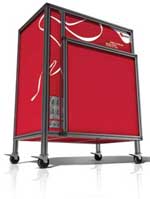 With the recent inclusion of MIMO into both WiMAX and LTE standards, MIMO technology is booming. In an unusual multidisciplinary approach, multi-mode multi-cavity microwave applicator, signal-processing, aperture-iris coupling and RF antenna engineering techniques are being jointly applied to provide realistic and repeatable emulation of MIMO. As a result, EMITE Ing has developed the E300 MIMO Analyzer, which measures 0.82 × 1.425 × 1.95 m. With nine wideband antennas, different DUT-holder stirring positions, polarization stirring, two mechanical stirrers, 18 iris-coupling aperture stirring and variable frequency stirring, it avoids the use of a rotating platform, and therefore the need to make MIMO measurements using switched-mode or virtual array techniques.
With the recent inclusion of MIMO into both WiMAX and LTE standards, MIMO technology is booming. In an unusual multidisciplinary approach, multi-mode multi-cavity microwave applicator, signal-processing, aperture-iris coupling and RF antenna engineering techniques are being jointly applied to provide realistic and repeatable emulation of MIMO. As a result, EMITE Ing has developed the E300 MIMO Analyzer, which measures 0.82 × 1.425 × 1.95 m. With nine wideband antennas, different DUT-holder stirring positions, polarization stirring, two mechanical stirrers, 18 iris-coupling aperture stirring and variable frequency stirring, it avoids the use of a rotating platform, and therefore the need to make MIMO measurements using switched-mode or virtual array techniques.
Unlike conventional reverberation chambers, the MIMO Analyzer operates in both reverberating and non-reverberating modes, avoiding polarization imbalance, and is able to emulate a wide variety of Rayleigh, Rician, isotropic and non-isotropic environments from 690 MHz to 12 GHz.
Emulating capabilities
The 8 × 8 MIMO Analyzer provides both non-physical—correlation, mutual coupling, effective, ideal and apparent implemented diversity gain, efficiency (η), diversity gain loss (DGL) due to efficiency/user, MIMO capacity (CMIMO), capacity loss (CLMIMO) due to efficiency/user, mean effective gain (MEG) and effective mean effective gain (EMEG)—and physical parameters—angle of arrival (AoA), angular spread (AS), number of scatters (NS), number of multipath components (MPC)—to the MIMO engineer. The E300 Series also provides for active parameters like Total Radiated Power (TRP) and Total Isotropic Sensitivity (TIS) for 3GPP/CTIA compliance testing. The physical effect of the user on the above parameters can also be measured by an agreement with Schmid and Partner Engineering AG (SPEAG), whereby the SAM v4.5BS head and SHO v2RBLB hand phantoms are employed in conjunction with the MIMO Analyzer.

Figure 1 Measured diversity gain using the E300 MIMO Analyzer.
Some of the different definitions of diversity gain measured with the E300 are illustrated in Figure 1. Similarly, MIMO capacity is measured using the measured channel samples between each of the MIMO receiving antennas (R) and each one of the transmitting ones (T). The recently defined efficiency-or-user related parameters of DGL and CLMIMO can also be measured using the new MIMO Analyzer.
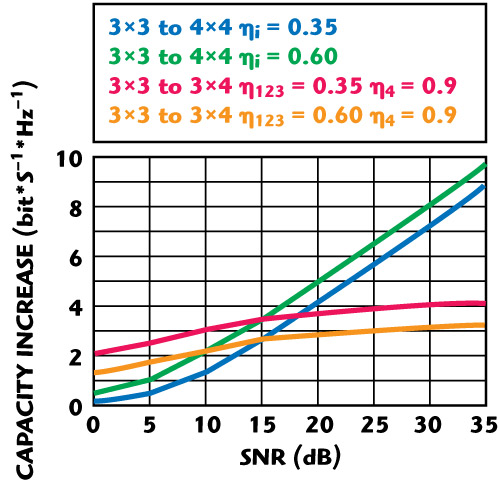
Figure 2 Measured capacity increase using the E300 MIMO Analyzer.
Since it is highly unlikely that all receiving antennas have the same efficiency, these two parameters help identify the MIMO design optimum β=T/R for a specific fading environment and angular spread, as depicted in Figure 2, or even for a variety of fading conditions through automatic multiple tests in the MIMO Analyzer.

Figure 3 Rician benchmarkng for the E300 MIMO Analyzer.
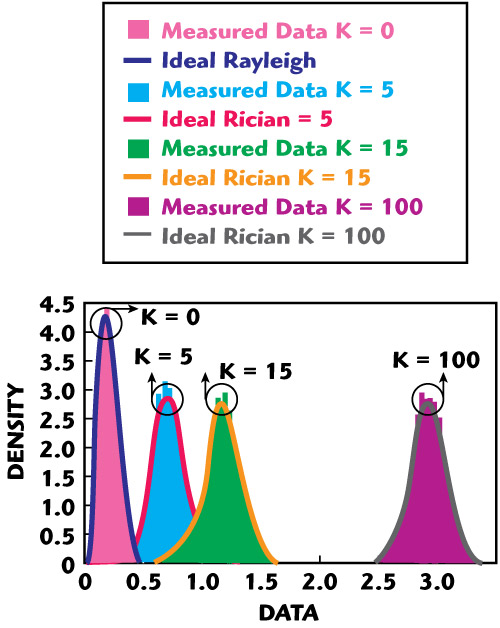
Figure 4 Some measured Rician distributions at the E300 MIMO Analyzer.
In addition, the instrument is able to emulate Rician-fading environments. To do this, a combination of smart-stirrers movement, variable iris-coupling, holder position and sample-selection by genetic algorithms is used. The MIMO Analyzer can specify the contribution of each sample to final fading environment emulation, providing for an accurate way of determining Rician-fading environments (patent protected). Rician benchmarking is shown in Figure 3, while different K-factors obtained from measured data analyses and their data distribution is shown in Figure 4.
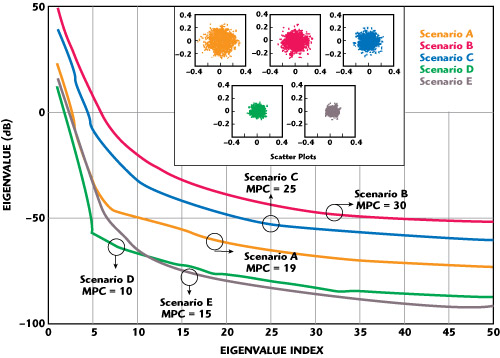
Figure 5 Eigenvalues for some scenarios at the E300 MIMO Analyzer.
The E300 can also repeatably emulate both isotropic and non-isotropic fading scenarios, providing for MPC and AoA histograms of measured data, along with the measured values of angular spread and number of scatters. In Figure 5, the measured eigenvalues of the data matrix for some emulated scenarios are depicted.
Two techniques for emulating non-isotropic scenarios are available on the MIMO Analyzer: A decrease in the main cavity Q-factor and the combined use of a wide coupling aperture and a relatively-large T-R separation with a non-reverberating mode with the door open (patent protected).
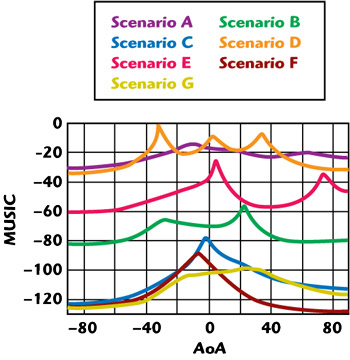
Figure 6 Some AoA histograms at the E300 MIMO Analyzer.
Figure 6 shows the measured angle of arrival for some emulated scenarios. Angular spreads ranging from 36 to 85 have successfully been emulated by EMITE Ing and incorporated onto the MIMO Analyzer firmware. In some emulated scenarios a high degree of non-isotropicity is observed, with up to 50 dB power differences for diverse angles.

Figure 7 TRP benchmarking for GSM900.
Finally, the E300 is also able to measure TRP and TIS for compliance testing purposes, serving the pre-compliance design and testing stages with a final certification of performance. Figure 7 shows a comparison of TRP measured with the E300 MIMO Analyzer, the SATIMO SG24 and EMSCAN LabExpress. This feature was not included in the E300 predecessors, the E200 and E100 Series, which can be acquired at a lower cost.
Applications
The E300 is ideally suited for MIMO applications that simply cannot be simulated, such as the use of metamaterial antennas for wireless terminals. The radiating element length in a mobile phone can be reduced between 1/15th and 1/20th of the wavelength using metamaterials. A four-element 2.4 GHz MIMO antenna, for example, will fit in a volume of only 48 × 8 × 0.8 mm, without sacrificing efficiency. It is also an excellent tool for identifying the maximum allowable Shannon capacity of the RF antenna front-end, which poses a limit to the baseband MIMO algorithm and places its performance into context.
Another key deployment where the new MIMO Analyzer can be helpful is that of femtocells, where interference is an issue. Trials have shown that in some situations, particularly buildings with thick concrete floors, coverage may not penetrate the entire desired area, and then the RF interface acquires great importance. The ideal femtocell will support multiple standards simultaneously, and with significant levels of voice and data performance, MIMO technologies will be exploited.
Now that the IEEE 802.11n WiFi standard is a reality, WiFi systems with pre-N products based on draft versions of the standard can be tested by the MIMO Analyzer and certified for the recently approved standard. The pre-N products have been able to multiply existing peak data rates of IEEE 802.11g by 5 to 20 Mbps. Speed can go up to 150 Mbps raw symbol rate when combined with 40 MHz channels, and 600 Mbps are said to be achievable with four spatial streams.
Another application is that of fixed wireless access (FWA) in WiMAX (IEEE 801.16) or mobile WiMAX/WiBRO (IEEE 802.16e). Time-division duplex (TDD) WiMAX includes several types of MIMO. In the predicted downlink schemes for mobile WiMAX, the criterion to switch between Matrix-A (STBC) and Matrix-B is based upon the scheme that gives the highest spectral efficiency. It is here where the MIMO Analyzer can be helpful in identifying such selection for specific MIMO array prototypes in diverse emulated scenarios.
Also, in the mobile WiMAX evolution, MIMO is also being added to frequency-division duplex (FDD) mobile WiMAX. Both the IEEE 802.16 Working Group and the WiMAX Forum aim to get twice the spectral efficiency of mobile WiMAX release 1.0 in several metrics at both the downlink and uplink using MIMO. The same is true for IEEE 802.16m (WiMAX 2 II/Wave 2) and pre-LTE transition standards like HSPA evolution (HSPA+). The foreseen MIMO technologies embedded into LTE have to be carefully tested and validated against realistic fading environments using the MIMO Analyzer.
Furthermore, wireless is rapidly moving beyond the handset and even the PC and becoming included in every new device or media platform. One niche application is that of embedded in-car wireless systems for vehicle-to-vehicle (VtV), vehicle-to-infrastructure (VtI) or inter-vehicle communication (IVC). These systems include MIMO techniques in order to achieve fast data rates in harsh communications environments. DSRC/WAVE (IEEE 802.11p) systems fill a niche in the wireless infrastructure by facilitating low latency, geographically local, high data rate and high mobility communications.
Some applications envisioned using DSRC include applications such as local danger warning, vehicle collision avoidance, traffic control and remote toll collection, emergency warning systems for vehicles, cooperative adaptive cruise control, cooperative forward collision warning, and intersection collision avoidance. In addition, a plethora of more demanding applications, such as high-speed networking, video streaming and mobile commerce, are envisioned.
An in-vehicle infotainment/safety system fully integrated to the phone could also certainly make use of MIMO to solve the large variability of link conditions, particularly the non-stationary nature of the fading behavior with temporary high path loss and a strong shadowing influence. MIMO, which is already being tested by car makers worldwide, could be the answer.
MIMO techniques for VtV communication could be used either to obtain large capacities or to reduce interference effects through spatial filtering. Here, channel modeling is critical and MIMO measurements are essential to identify prototype performance in an environment with a widely changing K factor. The E300, which is able to emulate diverse K factors and nonisotropicity, could simplify MIMO test and measurement for these prototypes.
Similarly, the UWB air interface (IEEE 802.15.3a) is expected to enable peak download data rates of 288 Mbps in a 20 MHz bandwidth. It uses OFDMA with sophisticated control and signaling mechanisms, radio resource management (RRM), adaptive reverse link (RL) interference management, and, of course, MIMO.
Throughput gains of between 20 to 40 percent using MIMO relative to SIMO have already been observed in drive tests. Since UWB supports both single user and multiuser MIMO, it is also a good candidate to be tested using the versatility of the MIMO Analyzer. Some other mm-wave standards that may include MIMO techniques are WirelessHD (WiHD), IEEE 802.15.3c or IEEE 802.11 VHT60, among others.
Conclusion
The E300 MIMO Analyzer has an emulating performance well beyond conventional reverberation chambers, which are limited to Rayleigh-fading and isotropic behavior. Standardization is also on the way following the recent Vodafone proposal to 3GPP to use the reverberation chamber technique as an alterative to OTA systems for MIMO measurements. The MIMO Analyzer delivers accurate, fast and repeatable MIMO measurements, all united in a single and intuitive interface, and can drastically reduce research, production and compliance testing costs and time to market. These capabilities also provide a basis for comparing test results as system hardware/software is changed, or alternate devices are tested, or even when new materials are employed. Automated testing improves time to market, test coverage, repeatability as well as the collection and archiving of the results.
Increased broadband speeds are driving the development of new categories of devices such as smartphones, mobile Internet devices, ultra mobile PCs and netbooks, where MIMO has to be fully integrated. Consequently, the new MIMO Analyzer is of interest to both 3.5/4G cellular handset and non-handset wireless device manufacturers, including the chipsets, cellular phones, smartphones, wireless LAN access points, 4G base station antennas, HSPA+ routers, compact handheld mobile computers, PCMCIA cards, PDAs, netbooks, etc. The low-cost E300 is an important new tool for evaluating final product performances as well as MIMO conformance tests and compliance testing in an efficient, fast and accurate way.
EMITE Ing,
Murcia, Spain,
Tel. + 34 968 100181,
e-mail: sales@emite-ing.com
www.emite-ing.com
RS No. 300
